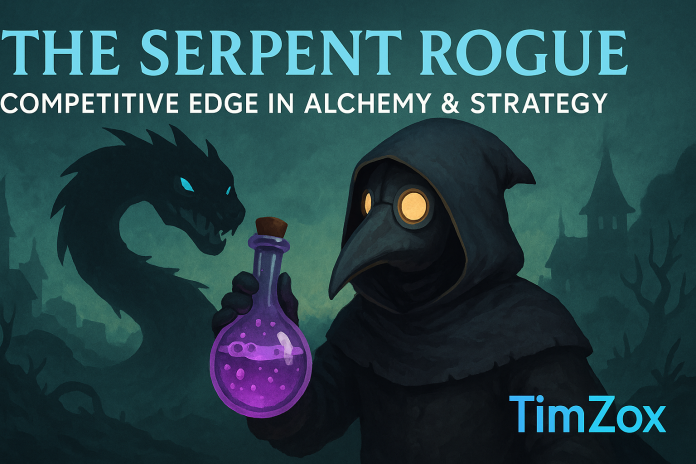In today’s saturated market of action-adventure titles, few games manage to carve a niche that blends gameplay innovation with atmospheric storytelling. Enter The Serpent Rogue, a botanical action-adventure game developed by Sengi Games and published by Team17. Released in 2022 across PC, Xbox Series X|S, PlayStation 5, and Nintendo Switch, the game has earned praise for its alchemy-driven gameplay and roguelike elements.
But what exactly gives The Serpent Rogue its competitive edge?
This article analyzes the game’s mechanics, design philosophy, and market reception to uncover how it differentiates itself from others in the genre—and why professionals in game development, publishing, and content creation should take note.
Gameplay Mechanics: Strategic Alchemy
At the core of The Serpent Rogue lies an intricate alchemy system. Players embody “The Warden,” a plague-masked alchemist who must master the art of potion-making to restore balance in a corrupted world.
Key Features:
-
Ingredient Discovery: Players must explore the map to find herbs, animal parts, and mysterious substances.
-
Experimental Crafting: The game rewards experimentation with complex recipes that can influence enemies, allies, and the environment.
-
Limited Resources: Alchemical ingredients are not infinitely available, forcing resource management akin to survival horror games.
Competitive Advantage: Few action-adventure games offer a crafting system as central and in-depth as The Serpent Rogue‘s alchemy engine. This elevates strategic thinking and player immersion.
Environmental Interaction & Dynamic World-Building
The world in The Serpent Rogue is not static. The game features a reactive environment where your actions have ripple effects.
Environmental Dynamics:
-
Time-Based Events: Corruption spreads in waves, altering maps and NPC behaviors.
-
Cause-and-Effect Logic: Dropping spoiled food may attract rodents; leaving potions unattended can create unintended chaos.
-
NPC Autonomy: NPCs react to hunger, threats, and assistance, offering emergent gameplay.
Competitive Edge: This systemic interaction adds a sandbox quality that enhances replayability, giving it an edge over linear or static worlds.
Visual Design & Immersive Aesthetics
The game’s distinct art direction blends hand-painted gothic visuals with a somber palette that evokes mystery and foreboding. This stylistic coherence strengthens narrative immersion.
Key Visual Elements:
-
Gothic Environments: Derelict towns, ancient ruins, and corrupted lands all tell a visual story.
-
Animation Fluidity: Despite being a small studio project, character animations are smooth and polished.
-
UI/UX: Clean and thematic UI design aids player navigation without breaking immersion.
SEO Tip: Visual design plays a crucial role in user engagement metrics like bounce rate and dwell time, which can affect SEO rankings.
Narrative Design & Player Agency
The story is told through fragmented environmental storytelling and lore objects, creating a puzzle-like narrative structure.
Narrative Highlights:
-
Minimal Handholding: Players must deduce objectives, giving a sense of discovery.
-
Moral Choices: Decisions like whether to revive a corrupt creature or destroy it influence how the world unfolds.
-
Non-Linear Progression: The absence of a strict quest line encourages exploration.
Expert Insight: This design mirrors techniques from games like Dark Souls and Hollow Knight, appealing to players who value depth and narrative subtlety.
The Challenge of Combat & Survival
Combat is deliberately measured and not the game’s main attraction. However, when fights occur, they are unforgiving and resource-intensive.
Combat System:
-
Stamina-Based Attacks: Encourages timing over button-mashing.
-
Potion-Driven Combat: Potions can poison enemies, heal allies, or cause area effects.
-
Death Consequences: Dying may lead to the loss of items and progress, introducing roguelike stakes.
Competitive Distinction: While many action titles focus on flashy combat, The Serpent Rogue prioritizes cerebral, survival-oriented play.
Player Reception & Critical Reviews
What Critics Are Saying:
-
Screen Rant: 9/10 – “A hauntingly beautiful, complex narrative adventure.”
-
GamingTrend: “A wondrous alchemic adventure that rewards curiosity and patience.”
-
Checkpoint Gaming: Points to potential but notes the execution feels slightly unfinished.
Player Feedback:
-
Steam rating: “Mostly Positive”
-
Common praises: Crafting depth, art direction, exploration freedom
-
Common criticisms: Steep learning curve, sparse tutorials
Conclusion: The game strikes a chord with players looking for slower-paced, meaningful gameplay.
Comparison with Genre Peers
| Feature | The Serpent Rogue | Hollow Knight | Potion Craft |
|---|---|---|---|
| Central Alchemy System | ✅ | ❌ | ✅ |
| Reactive Environments | ✅ | ⚠️ Partial | ❌ |
| Procedural Combat | ⚠️ Light | ✅ | ❌ |
| Narrative Puzzle Solving | ✅ | ✅ | ⚠️ Minimal |
| Exploration Focus | ✅ | ✅ | ⚠️ Minor |
This comparison reveals that The Serpent Rogue stands out due to its fusion of alchemy and world-reactivity.
Future Prospects & Market Longevity
Update Potential:
-
Room for expanded potion types, AI behaviors, and world-building
-
Modding community interest could provide long-term engagement
Monetization Strategy:
-
Cosmetic DLCs and alchemy-based expansions could extend shelf life
-
Cross-platform support ensures broad audience reach
Market Insight: Titles with sandbox features and high replay value often maintain player bases longer than linear adventure games.
Read Also: Mashable Connections Hint Today: Solve NYT’s Puzzle Fast!
Conclusion: The Sustainable Edge
The Serpent Rogue‘s competitive edge lies in its:
-
Deep, rewarding alchemy system
-
Reactive, atmospheric world
-
Emphasis on experimentation and strategic planning
-
Willingness to forgo instant gratification for long-term payoff
For developers, marketers, and gaming analysts, this title serves as a case study in how to blend genre expectations with innovative mechanics to capture and retain player interest.
Whether you’re a game dev seeking inspiration or a seasoned gamer looking for the next hidden gem, The Serpent Rogue delivers an experience that’s both intellectually stimulating and emotionally immersive.


